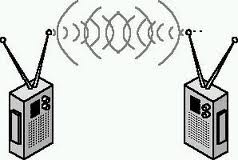COMPUTER NETWORKING
· Connecting to a computer with other computers or other devices to enables them to communicate together with each other.
-it can be : - devices equipment
- transmission media to send/control data/signals
- communication devices to transmit/send data from source to destination
-it can be : - devices equipment
- transmission media to send/control data/signals
- communication devices to transmit/send data from source to destination
· In the world of computer, NETWORKING is the practice of linking two or more computing devices together for the purpose of SHARING DATA.
NETWORK COMPONENTS
v Terminals
-Refers to data sources and destination .
examples-workstation,personal computer,terminals,automatic teller machine
-Refers to data sources and destination .
examples-workstation,personal computer,terminals,automatic teller machine
v Transmission Media
-Used to transmit data in a networked environment and transmit pulse through a medium. There are 2 types of it, bounded and unbounded.
-Used to transmit data in a networked environment and transmit pulse through a medium. There are 2 types of it, bounded and unbounded.
v Network electronic devices
- Control data transmission from sources to destinations. It also act as interface between different transmission media or communication protocol. For examples: Bridges, concentrators, routers, Front End Processors, Private Branch, Switches Exchange (PBX), Hubs, Multiplexers, and Gateways.
v Software:
-At the nodes, it involves techniques and protocols. Functions of the software are measure the data transmits to the destination.
v Network architecture standards:
-Architecture is blueprint of standards for a network consisting of items such as choice of media, media interfaces, encoding methods, transmission protocols, routing protocols and so on. It is needed to ensure interoperability between various devices and equipment made by different vendors.
LAN - Local Area Network (LAN) is a small-scale private network inside the building. LANs are often used for connecting personal computers and workstations in a corporate office or factories to use shared resources (e:g printers) and exchange information.
MAN - Metropolitan Area Network (MAN) basically a LAN version of the larger size and usually use the same technology to the LAN. MAN could include corporate offices are located adjacent or also a town and can be used for private purposes (private) or public. MAN is able to support data and voice, even may be associated with cable television network.
WAN - Wide Area Network (WAN) its scope covers a wide geographical area, often covering a country or even continent. WAN consists of a collection of machines that aim to run the programs (applications) user.
VIRTUAL PRIVATE NETWORK (VPN )
PAN - Personal Area Network
BLUETOOTH
Bluetooth is a proprietary open wireless technology standard for exchanging data over short distances (using short-wavelength radio transmissions in the ISM band from 2400–2480 MHz) from fixed and mobile devices, creating personal area network (PANs) with high levels of security. It can connect several devices, overcoming problems of synchronization. The devices can switch roles, by agreement, and the slave can become the master. At any given time, data can be transferred between the master and one other device.
INFRA-RED
This is a very familiar method of transferring data if you are at all aware of your remote control ! The television remote control makes use of an infra-red link. Personal organisers often make use of an infra-red link to synchronise calendars and 'to-do' lists.
Amplitude Modulation.
ü Method of broadcasting electrical signals that cannot travel very far on their own. In this method, the signal is imposed or 'imprinted' on a carrier wave whose amplitude increases or diminishes with the amplitude of the signal. AM transmission operates in the 535 to 1705 kilohertz frequency band used for shortwave broadcasting and some citizen band (CB) aviation services. See also frequency modulation.
Freqeuncy modulation.
ü Method of broadcasting electrical signals that cannot travel very far on their own. In this method, the signal is imposed or 'imprinted' on a carrier wave whose frequency increases or diminishes with the frequency of the signal. FM transmission operates in 88 to 108 megahertz frequency band, and is less susceptible to electromagnetic interference than amplitude modulation (AM).

















